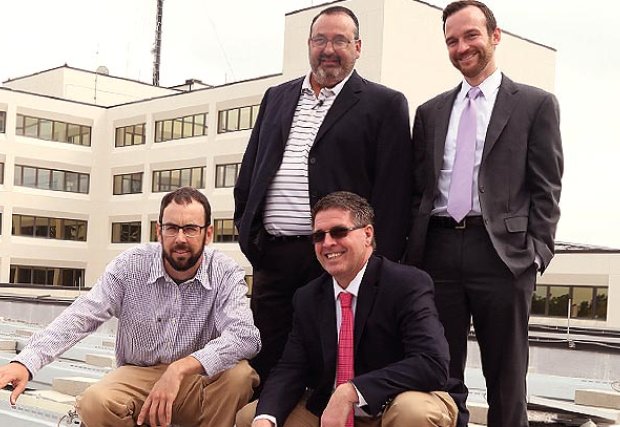Chris Howard, from Southern View Energy (L) demonstrates to CEO Vance Reynolds (R), Ray Hoyer (Standing, L) and COO Matt Merrifield (Standing, R), how the solar panels work.
"We have installed an onsite generation capacity of 100 KW. Since 2013, our campus has received the Energy Star® certification by reducing total emissions and numerous other energy initiatives. The solar panels will help us further reduce our costs and are a source of clean energy that won’t need to come from the power grid,” says Director of Plant Operations Ray Hoyer, CHFM, CHSO, CHEP.
The idea came about in early 2016 when Chief Executive Officer Vance Reynolds met Christopher Howard, a Business Development Manager from Southern View Energy. “South Carolina has a renewable energy portfolio, which means power companies are required to obtain a portion of their energy from renewable sources, such as the wind and the sun,” says Chris. “I discussed the idea of solar panels for Aiken Regional with Vance, and explained how the panels could make a big difference in reducing their reliance on traditional energy sources and lowering their costs.”
The project was approved in September 2016 and the system, including 312 solar panels, was installed on the roof and operating by the end of January 2017. “The panels are tilted on a 10-degree tilt for maximum density and production,” says Ray. “The project went smoothly and took about three weeks to complete.”
Vance says Aiken Regional’s conversion to solar panels and other forms of renewable energy, such as switching to LED lights in the parking lots, demonstrates their ongoing commitment to a cleaner environment, decreasing energy consumption, and lowering costs. “In the last seven years, we have saved about 10 percent in energy costs due to efficiency initiatives,” he says. “Installing the solar panels allows the power company to buy the energy that is being generated by our solar panels. That shows up as a credit on our bill, and also reduces our carbon footprint.”
Why Go Solar?
The benefits of using solar panels are numerous.
Solar Panel System Performance
Ray says that an application from the inverter manufacturer allows the hospital team to see real-time data of their energy usage on a minute-by-minute basis, as well as by day, month and lifetime. The environmental benefits from the use of the solar panels are also shown. In one year’s time, the potential environmental savings from the solar panels will be equivalent to taking 18 cars off the road, saving 83,566 gallons of water and 28.1 acres of trees. “Other energy-saving projects will include retrofitting lights in the buildings, improving the operational efficiency of HVAC systems and exploring additional alternate energy sources,” he says.
The Cost and Savings of Going Solar
Converting to solar power is usually a significant investment. However, with federal and state tax credits, the hospital was able to reduce their return on investment from five years to four. “The energy generated by the panels is credited on our electric bill. Once we have paid off our investment, the panels will continue to help us reduce our energy costs,” says Ray. “The system has a 25-year warranty and can last for least 30 years, so we plan to have this for a long time.” The panels are low maintenance, needing only an annual cleaning and some electronic testing to make sure they are working. Troubleshooting can be done remotely. Chris says the cost of converting to solar energy has gone down 20 percent in the last year and a half. “This was a good time for Aiken Regional to purchase their system. There has been an increase in requests because residents and businesses alike are interested in other means of energy and reducing their use of the main power grids,” he says. Because of the hospital’s success with the solar panels, the same system will be installed on the roof of the Carolina Cancer Institute this year. “The project has already been approved. There will be 238 panels on top of the cancer center, and that should equate to even more savings off our electric bill,” says Ray.

